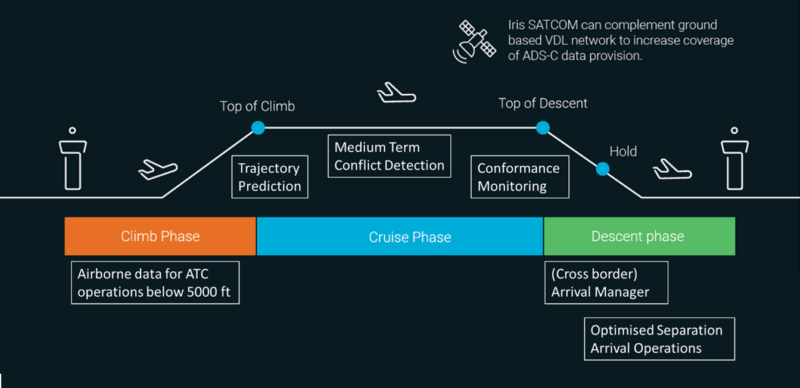Last summer we described how Automatic Dependent Surveillance – Contract Baseline 2 (ADS-C B2) communications technology could enhance Air Traffic Control tools, increasing safety and supporting the aviation industry’s target zero objectives.
One year later, the joint research efforts of NATS and partner organisations including Airbus, Airtel, DFS, DSNA, ENAV, ESSP, EUROCONTROL, Indra, and Thales in SESAR Projects ‘ADSCENSIO’ and ‘4D Skyways’, have provided further evidence of the capabilities of ADS-C B2. This technology has the potential to improve the accuracy of ATC prediction and queue management tools, generating significant safety and environmental benefits.
Results
For the first time, NATS evaluated ‘Time of Arrival Range’ (TOA Range) data. This provides the minimum (earliest) and maximum (latest) estimated time of arrival (ETA) over a specified waypoint along an aircraft’s 4D trajectory. This evaluation, conducted on London arrival waypoints for Heathrow and Gatwick, demonstrated high accuracy and stability.
TOA Range could enable queue management tools to individually tailor speed instructions to absorb predicted delay in the cruise, significantly improving the sequencing of arriving aircraft while reducing emissions.

TOA range computation for ‘waypoint 4’ along a route
NATS also assessed the potential of using aircraft mass and predicted speed data to enhance trajectory prediction (TP) calculations.
Trajectory Predictions based on the BADA aircraft performance model were compared with predictions enhanced using ADS-C data. The analysis concluded that using ADS-C mass significantly improves the accuracy of the predictions, which could enable crucial benefits for ATC.
A related NATS assessment also found that the Medium-Term Conflict Detection (MTCD) system, which warns controllers of potential conflicts up to 20 minutes ahead, showed quantifiable improvements in accuracy, stability, and uncertainty metrics when utilising ADS-C data. This enhancement generated a measurable reduction in the number of missed alerts, indicating a positive potential impact on overall safety.
NATS researchers also undertook a real-time simulation focused on proactive 3D conformance monitoring in vertically constrained airspace, comparing the current airspace scenario with new standardised route procedures and 3D conformance monitoring support functions. The successful test demonstrated the potential to detect discrepancies and display them to the controller, improving safety and increasing operational efficiency.

Extended Project Profile display including 3D information and discrepancies depicted by the bold line.
NATS research also investigated ADS-C Meteorological Information which is a reliable source given it’s being measured by aircraft sensors. The ADS-C MET data has the potential to supplement existing meteorological forecasting, improving the accuracy of the ground tools by using more up-to-date empirical measurements.
The ‘ADSCENSIO’ project also demonstrated the first use of an ‘ADS-C Common Service’ (ACS) architecture, to establish and share ADS-C data with multiple ATC centres. NATS developed and tested a ‘client’ to receive ADS-C reports and request Demand Contracts from the ACS prototype hosted in Germany. This novel architecture approach will be crucial for ensuring that the benefits of ADS-C can be realised with minimal impact on the radio spectrum that is also used for controller-pilot data link communications, and the limited number of ADS-C data connections on each aircraft. Further research work will continue on this topic in the next stage of SESAR as part of the ‘HERON’ project.
The collaborative efforts in SESAR projects ‘ADSCENSIO’ and ‘4D Skyways’ have yielded further promising results for ADS-C technology. The potential to enhance safety, optimise air traffic flow, and support the aviation industry’s target zero objectives are evident. As NATS and partner organisations continue to advance ADS-C capabilities, this technology will play an ever-more crucial role in shaping the future of air traffic control, bringing the aviation industry closer to digital skies.
The work described in this article has received funding from the SESAR Joint Undertaking under the European Union’s Horizon 2020 research and innovation programme under grant agreement No’s 101017626 and 872320. The opinions expressed herein reflect the author’s view only. Under no circumstances shall the SESAR Joint Undertaking be responsible for any use that may be made of the information contained herein.
Comments
Please respect our commenting policy and guidelines when posting on this website.

12.10.2023
08:27
Chris Vaughan
Great to see research continues in the area of Air Ground Data Link systems, and pleased to see the work has evolved since the original B2 trials with your SESAR partners. Great work, Richard.
Hopefully NATS will build iteratively on its current ATS-B1 foundation, to create a seamless CPDLC and ADS-C experience using best-in-class technology and ensure best RoI from any future ATS-B2 implementation which arises from this research.